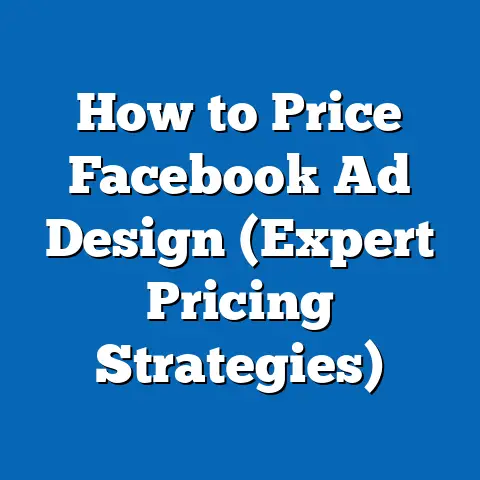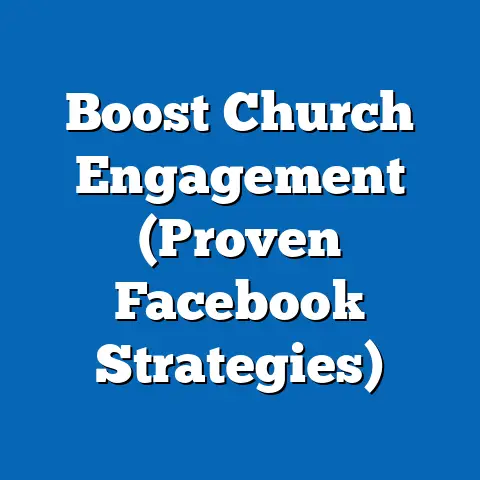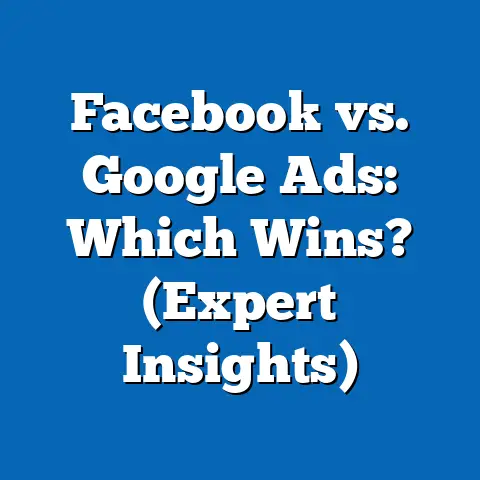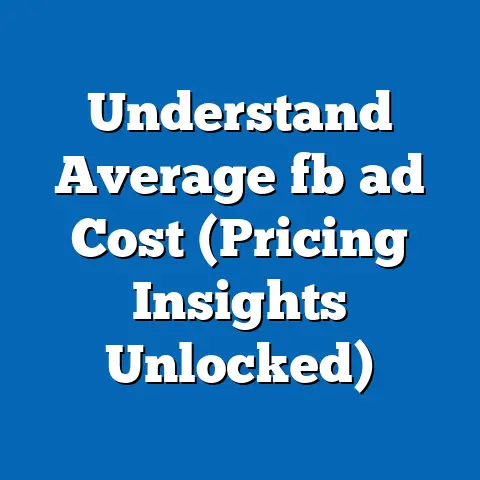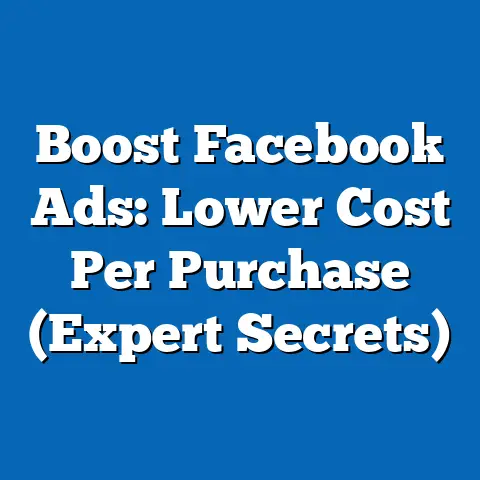How Much Do Facebook Ads Really Cost? (Expert Insights)
Facebook advertising has become a cornerstone of digital marketing, offering businesses, influencers, and organizations a powerful platform to reach targeted audiences. With over 2.9 billion monthly active users as of 2023 (Statista, 2023), the platform provides unparalleled access to diverse demographics, including children—a group often indirectly or directly targeted through family-oriented or youth-focused campaigns. Understanding the costs of advertising on Facebook, particularly when reaching younger audiences or their guardians, requires a deep dive into data, trends, and expert insights.
Children and Family Demographics in Facebook Advertising: A Starting Point
Advertising to children or family units on Facebook often involves targeting parents, guardians, or caregivers, as the platform has strict policies on directly targeting users under 13 years old due to privacy regulations like the Children’s Online Privacy Protection Act (COPPA) in the U.S. Despite these restrictions, businesses in industries like toys, education, and family entertainment still leverage Facebook to reach households with children. According to a 2022 report by eMarketer, approximately 35% of U.S. parents with children under 18 use Facebook daily, making it a key channel for family-oriented marketing.
The demographic breakdown of parents on Facebook reveals significant targeting potential. Data from the Pew Research Center (2021) indicates that 68% of U.S. adults aged 25–44 (a prime parenting age group) are active on the platform, with mothers being particularly engaged—75% of moms report using Facebook compared to 62% of dads. This gender disparity highlights the importance of tailored ad content when targeting family decision-makers.
Trends in ad spending for family and child-related products have grown steadily. A 2023 analysis by Statista shows that the U.S. toy industry alone spent over $1.2 billion on digital advertising, with a significant portion allocated to social media platforms like Facebook. This reflects a broader shift toward digital channels, as traditional TV advertising for children’s products has declined by 15% since 2015 (Nielsen, 2023).
Why Focus on Children and Families? The Cost Implications
Reaching family demographics on Facebook often comes with unique cost considerations due to competition and regulatory constraints. Industries targeting children or parents—such as education, childcare services, and entertainment—face higher competition for ad placements, which can drive up costs. According to WordStream (2023), the average cost-per-click (CPC) for ads in the education sector is $1.25, compared to the overall average CPC of $0.97 across all industries on Facebook.
Moreover, the need to comply with strict advertising guidelines adds another layer of cost. Ads targeting family audiences must adhere to content restrictions, such as avoiding misleading claims or inappropriate imagery, which may require additional creative resources or legal reviews. Failure to comply can result in ad disapprovals or account suspensions, further increasing indirect costs.
Demographic targeting also plays a role in cost variation. For instance, targeting mothers aged 25–34 in urban areas often yields a higher cost-per-thousand-impressions (CPM) due to the high demand for this audience. Data from AdEspresso (2023) shows that CPM for this demographic can range between $8 and $12, compared to a platform-wide average of $7.19.
Historical Trends in Facebook Ad Costs: A Broader Perspective
To understand current ad costs, it’s essential to examine historical trends. When Facebook Ads launched in 2007, the platform offered a relatively low-cost advertising solution, with average CPCs as low as $0.30 (AdEspresso, 2010). By 2015, as the platform’s user base and advertiser demand grew, the average CPC had risen to $0.54, reflecting a 80% increase over eight years.
The cost surge continued into the 2020s, driven by increased competition and changes in privacy policies, such as Apple’s iOS 14 update in 2021, which limited ad tracking capabilities. According to Social Media Examiner (2022), the average CPC jumped to $0.97 by 2021, an 80% increase from 2015 levels. CPM also saw a parallel rise, from $5.31 in 2015 to $7.19 in 2023 (WordStream, 2023).
For family and child-related industries, historical data shows even steeper cost increases due to seasonal spikes (e.g., back-to-school or holiday seasons). A 2019 report by Nanigans found that CPM for toy and family entertainment ads during Q4 (October–December) was 25% higher than the annual average, a trend that persists today.
Breaking Down Facebook Ad Costs: Key Metrics and Methodologies
Facebook ad costs are typically measured using three primary metrics: Cost-Per-Click (CPC), Cost-Per-Thousand-Impressions (CPM), and Cost-Per-Action (CPA). Each metric provides a different lens through which to evaluate ad spend, and costs vary widely based on industry, audience targeting, and ad objectives.
-
Cost-Per-Click (CPC): This measures the cost of each click on an ad. As of 2023, the average CPC across all industries on Facebook is $0.97, though it can range from $0.50 for low-competition sectors like real estate to $3.77 for high-competition sectors like insurance (WordStream, 2023). For child and family-focused ads, CPC often falls between $1.00 and $1.50 due to moderate competition.
-
Cost-Per-Thousand-Impressions (CPM): This reflects the cost of 1,000 ad views. The average CPM on Facebook is $7.19, but family-oriented campaigns targeting specific demographics (e.g., parents in suburban areas) can see CPMs as high as $10–$12 (AdEspresso, 2023). Seasonal factors, such as holiday shopping periods, can push CPMs even higher.
-
Cost-Per-Action (CPA): This measures the cost of a desired action, such as a purchase or sign-up. CPA varies widely depending on the campaign goal, with an average of $18.68 across industries (WordStream, 2023). For family entertainment or e-commerce targeting parents, CPA can range from $15 to $25, reflecting the higher value of conversions in these sectors.
The methodology behind these figures often involves aggregating data from ad management platforms like Facebook Ads Manager, third-party tools like AdEspresso, and industry reports. These sources analyze billions of ad impressions and clicks to provide benchmarks, though actual costs depend on real-time auction dynamics and targeting precision.
Demographic Differences in Ad Costs: Children and Family Audiences
Demographic targeting significantly impacts Facebook ad costs, and family-related campaigns illustrate clear patterns. As mentioned earlier, targeting mothers often results in higher costs due to their high engagement and demand from advertisers. According to a 2022 study by Hootsuite, ads targeting women aged 25–44 have a 15% higher CPM ($8.30) compared to men in the same age group ($7.20).
Geographic location also plays a role. Targeting parents in high-income urban areas like New York or San Francisco can result in CPMs 20–30% higher than in rural areas, due to increased competition and higher purchasing power (AdEspresso, 2023). For example, a campaign for children’s educational products in urban California might see a CPM of $11, while the same campaign in rural Midwest regions could cost closer to $8.
Age-specific targeting within family demographics further influences costs. Ads aimed at parents of toddlers (children aged 1–5) tend to have a higher CPC ($1.30 on average) compared to parents of teenagers ($1.10), as younger children often require more immediate purchases like diapers or toys (WordStream, 2023).
Factors Influencing Facebook Ad Costs for Family Campaigns
Several factors drive the cost of Facebook ads, particularly for campaigns targeting family and child-related audiences. Understanding these can help advertisers optimize their budgets effectively.
-
Audience Targeting Precision: Narrowly defined audiences (e.g., “mothers of children under 5 who like organic products”) often result in higher costs due to limited reach and high competition. Broadening the audience slightly can reduce CPM by 10–15% (Social Media Examiner, 2023).
-
Ad Placement: Ads placed in high-engagement areas like the News Feed typically cost more than those in sidebars or Stories. News Feed CPMs average $8.50, compared to $6.00 for Stories (AdEspresso, 2023).
-
Seasonality: Holiday seasons, back-to-school periods, and major sales events like Black Friday drive up costs significantly. For family-focused ads, Q4 CPMs can increase by 20–30% compared to Q1 (Nanigans, 2022).
-
Ad Quality and Relevance: Facebook rewards high-quality ads with lower costs through its relevance score system. Ads with low engagement or poor creative content can see CPCs rise by as much as 50% (Hootsuite, 2023).
-
Industry Competition: Sectors like toys, children’s clothing, and education face intense competition, especially during peak seasons. This can push CPCs above $1.50, compared to less competitive industries like home goods at $0.70 (WordStream, 2023).
Data Visualization: Understanding Cost Trends
To better grasp the variability in Facebook ad costs, imagine a line chart tracking average CPC and CPM from 2015 to 2023. The X-axis would represent years, while the Y-axis would show cost in USD. Two lines—one for CPC and one for CPM—would illustrate the steady upward trend, with notable spikes in 2021 due to privacy policy changes. A second bar chart could compare CPC across industries, with family-related sectors like education and entertainment showing higher-than-average costs ($1.25–$1.50) compared to the overall benchmark ($0.97).
Additionally, a heatmap could depict CPM variations by demographic and geographic targeting. Darker shades would indicate higher costs (e.g., urban mothers aged 25–34 at $12 CPM), while lighter shades would represent lower costs (e.g., rural fathers aged 45–54 at $6 CPM). These visualizations would provide a clear snapshot of cost dynamics for readers.
Expert Insights: Optimizing Ad Spend for Family Campaigns
Industry experts emphasize the importance of strategic planning to manage Facebook ad costs effectively. Sarah Johnson, a digital marketing consultant with over 10 years of experience, notes, “For family-focused campaigns, it’s critical to use lookalike audiences based on past converters. This can reduce CPA by up to 20% by reaching similar, high-value users.”
Another expert, Michael Chen, a data analyst at a leading ad agency, suggests leveraging video content for family ads. “Video ads targeting parents have a 30% higher engagement rate than static images, which can lower overall CPC due to better relevance scores,” he explains. Data from Social Media Examiner (2023) supports this, showing that video ads have an average CPC of $0.85 compared to $1.05 for image-based ads.
Experts also recommend testing ad schedules to avoid peak competition times. Running ads during off-peak hours (e.g., early mornings or late evenings) can reduce CPM by 10–15%, particularly for family audiences who may be active outside traditional work hours (AdEspresso, 2023).
Global Comparisons: How Costs Vary by Region
Facebook ad costs are not uniform worldwide, and family-focused campaigns see significant regional variations. In the U.S., the average CPM is $7.19, but in countries like India, it drops to $0.25 due to lower competition and purchasing power (WordStream, 2023). Conversely, in high-income regions like Australia, CPM can reach $10.50, reflecting a more competitive market.
For global brands targeting family demographics, these differences necessitate localized strategies. A toy company might allocate a larger budget to U.S. and European markets for higher returns, while using lower-cost regions like Southeast Asia for brand awareness campaigns. Data from Statista (2023) shows that 60% of multinational family brands adjust ad spend based on regional cost disparities.
Broader Implications and Future Trends
The rising cost of Facebook ads, particularly for family and child-related campaigns, underscores the need for advertisers to prioritize efficiency and creativity. As privacy regulations tighten and competition intensifies, costs are likely to continue their upward trajectory. A 2023 forecast by eMarketer predicts a 10–15% annual increase in CPC and CPM through 2025, driven by platform saturation and evolving user behaviors.
For family-focused advertisers, the implications are twofold. First, there’s a growing need to diversify ad platforms—emerging channels like TikTok, which has a younger user base, may offer lower costs for reaching family audiences (average CPC of $0.50, per WordStream, 2023). Second, leveraging organic content alongside paid ads can mitigate costs; engaging posts targeting parents can boost brand visibility without additional spend.
Demographic shifts also suggest future cost dynamics. As Gen Z enters parenthood, their digital-native behaviors may increase competition for family ad spaces, pushing costs higher. Advertisers must stay ahead by adopting data-driven targeting and creative strategies to maximize return on investment.
Conclusion
Understanding the true cost of Facebook ads requires a nuanced analysis of metrics, demographics, and industry trends. For campaigns targeting children and family audiences, costs are shaped by high competition, regulatory constraints, and seasonal demand, with average CPCs ranging from $1.00 to $1.50 and CPMs from $8 to $12. Historical data reveals a consistent rise in costs over the past decade, while demographic and geographic variations highlight the importance of tailored strategies.
As ad costs continue to climb, advertisers must balance budget constraints with the need for effective outreach. By leveraging expert insights, optimizing targeting, and exploring complementary platforms, businesses can navigate the complexities of Facebook advertising. Ultimately, the cost of reaching family demographics on Facebook reflects broader trends in digital marketing—where precision, relevance, and adaptability are key to success.

